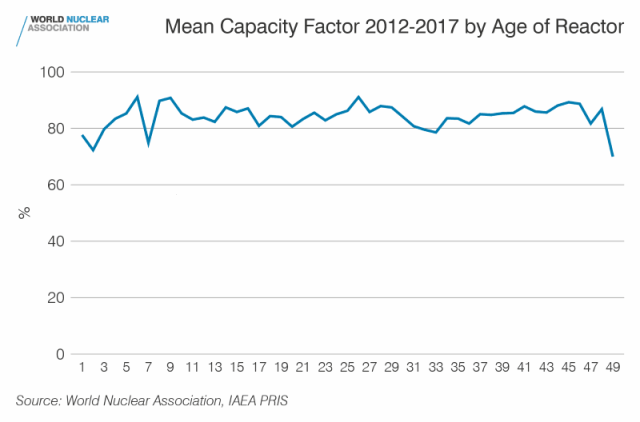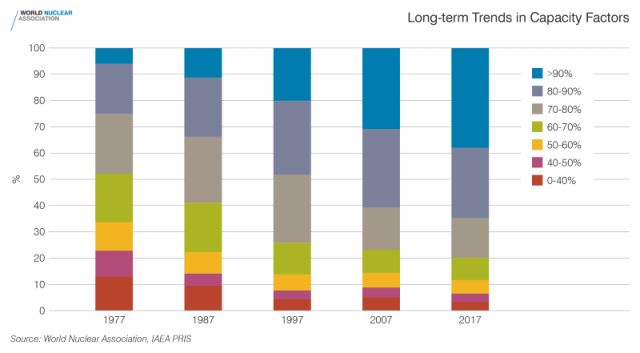Global nuclear generation increased in 2018 — for the sixth successive year.
Analysis published in the World Nuclear Performance Report shows that on average the world’s nuclear reactors show no significant age-related variation in performance.
The world’s nuclear reactors performed excellently in 2017. Global nuclear electricity output was 2506 TWh, an increase of 29 TWh compared to 2016.
The global nuclear capacity of the 448 operable reactors stood at 392 GWe at the end of 2017, up 2 GWe on the end of 2016 total.
Construction on more than 25 reactors will be completed in 2018 and 2019. The number of reactors under construction at the end of 2017 was 59.
Four new reactors were connected to the grid, with a combined capacity of 3373 MWe. Five reactors were shut down, with a combined capacity of 3025 MWe. However two of those reactors, Monju and Santa Maria de Garona, had not generated for some years previously.
The median average construction time for the four reactors grid connected last year was 58 months. In addition to the four grid connections, there were four construction starts and two construction projects halted. Both 2015 and 2016 had more grid connections, with ten each, and the nuclear industry have already had more grid connections in 2018 than in the whole of 2017.
The capacity factor for the global fleet stood at 81 percent, maintaining the high availability of around 80 percent that has been maintained since 2000, up from the 60 percent average capacity factor at the start of the 1980s.
“These records will be broken again in 2019. But countries like Brazil need to do more to develop nuclear generation if we are going to succeed in developing a global low carbon generation mix,” Agneta Rising, director general of World Nuclear Association said.
Kirill Komarov, chairman of World Nuclear Association, said that the world needs countries such as Brazil to lead the way in expanding their nuclear capacity.
 Excellent performance throughout long operating lives help nuclear reactors maximise their contribution to meeting energy and climate goals.
Excellent performance throughout long operating lives help nuclear reactors maximise their contribution to meeting energy and climate goals.
Agneta Rising said reactors are performing well regardless of their age, noting that Tarapur 1, a nuclear reactor situated on the coast of the western state of Maharashtra, India, had just passed the milestone of 50 years of supplying electricity.
This on-going excellent performance, in combination with a substantial new build program, can help nuclear energy reach its Harmony target of supplying 25 percent of the world’s electricity by 2050, Agneta Rising said.
Four other reactors are due to reach the same milestone this year, with Indian sister plant Tarapur 2, Beznau 1 in Switzerland and Ginna and Nine Mile Point 1 in the United States all due to pass 50 years since their first grid connection.

